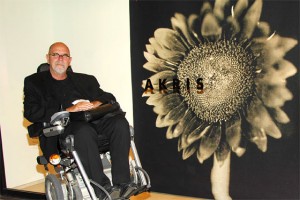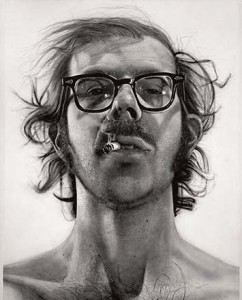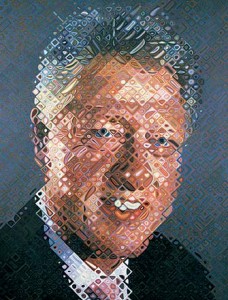Chuck Close
Bridgehampton, New York
Pace Wildenstein Gallery, New York
University of Washington, Seattle, B.A.
Yale University School of Art and Architecture, B.F.A., M.A.
Akademie der Bildenen Kunste, Vienna
Close is known for his large-format paintings in a style called “photorealism” or “superrealism”, which often involves using a grid technique to enlarge a photograph and treat each square as its own painting. His “Big Self Portrait” was the first of his mural-sized works, and took four months to complete. He carefully transferred each square’s detail with acrylic paint and an airbrush. His concern for photographic elements such as shape, texture, volume and shadow can be seen in his precise painting technique.
Following a B.A. from the University of Washington, Seattle and a B.F.A and M.F.A. from Yale University, he studied at Akademie der Bildenen Kunste in Vienna on a Fulbright Grant. Shortly after his return to New York City in 1967, Close’s work was included in the Whitney Biennial in 1969, followed by a solo exhibit in 1970 and an exhibit at New York’s MoMA in 1973.
Big Self Portrait, (1968) via Telegraph
In 1988, a spinal blood clot left him a quadriplegic. With the help and canvas preparation done by his assistants, he developed a new way of painting with a paintbrush between his teeth. He began to use grisaille (a technique which uses only grey tints) and pointillism (a technique of using dots of color that seem to fuse together froma distance) within the grids rather than the precise photorealistic style. Each square in the grid is still treated as a mini-painting, which comes together as one large painting when viewed from a distance.
Bill Clinton, (2006) via Telegraph
His portrait subjects have included Richard Serra, Phillip Glass, Cindy Sherman, and Kate Moss.
The Hermitage, St. Petersburg, February 29- April 13 [ArtObserved]
Chuck Close curates at Flag Foundation [ArtObserved]
Chuck Close documentary debuts in New York[ArtObserved]
White Cube Mason’s Yard [ArtObserved]
External Links






